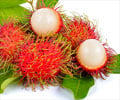Fruit flies exposed to methamphetamine drastically reduce their food intake and increase their physical activity just as humans do, says a new study.

The abuse of methamphetamine can have significant harmful side effects in humans. It burdens the body with toxic metabolic byproducts and weakens the heart, muscles and bones. It alters energy metabolism in the brain and kills brain cells.
Previous studies have shown that the fruit fly Drosophila melanogaster is a good model organism for studying the effects of methamphetamine on the body and brain. Researchers have found that meth exposure has similar toxicological effects in fruit flies and in humans and other mammals.
Some studies found that supplementing the fly's diet with added glucose or other metabolic precursors slowed the damaging effects of exposure to methamphetamine, suggesting that meth has a profoundly negative effect on metabolism. Human meth users are known to crave sugary drinks, an indication that their sugar metabolism, too, is altered by methamphetamine use.
"But previous research has not spelled out exactly how methamphetamine use affects energy metabolism," said University of Illinois, who led the new study with postdoctoral researcher Kent Walters. "Either it alters the expression of metabolic genes and/or the function of proteins, or it changes behaviors related to feeding and activity."
To test these competing hypotheses, the researchers monitored the fruit flies' energy reserves and other byproducts of metabolism in response to methexposure � with and without the addition of dietary glucose. They also tracked how meth affected the flies' feeding behavior, activity levels and respiration rates.
Advertisement
"This is very similar to what has been observed in humans for whom amphetamines can cause increased physical activity and decreased appetite," Walters said.
Advertisement
Adding glucose to the diet slowed the rate of decline and death in meth-fed flies, Walters said.
"While methamphetamine exposure has a lot of other toxic effects that also undermine an animal's health, we show that meth exposure leads to anorexia and the resulting caloric deficit exhausts the animal's metabolic reserves," he said. "This is likely a primary factor in meth-induced mortality."
The new findings further support the usefulness of the fruit fly as a model system to study the effects of methamphetamines, Pittendrigh said.
Source-Eurekalert















